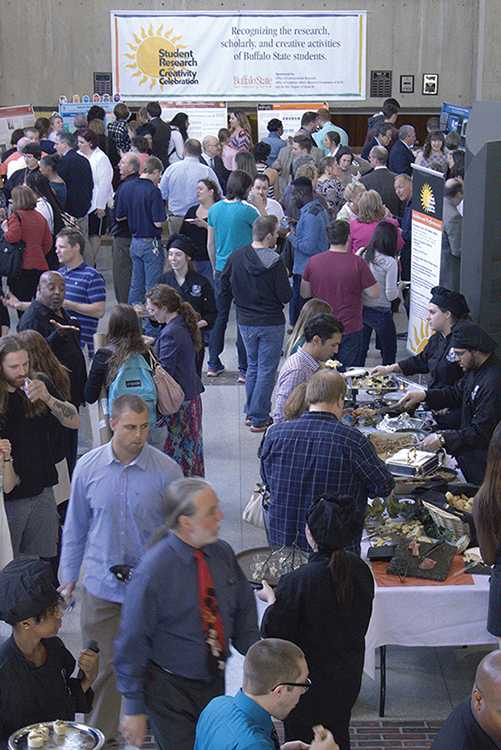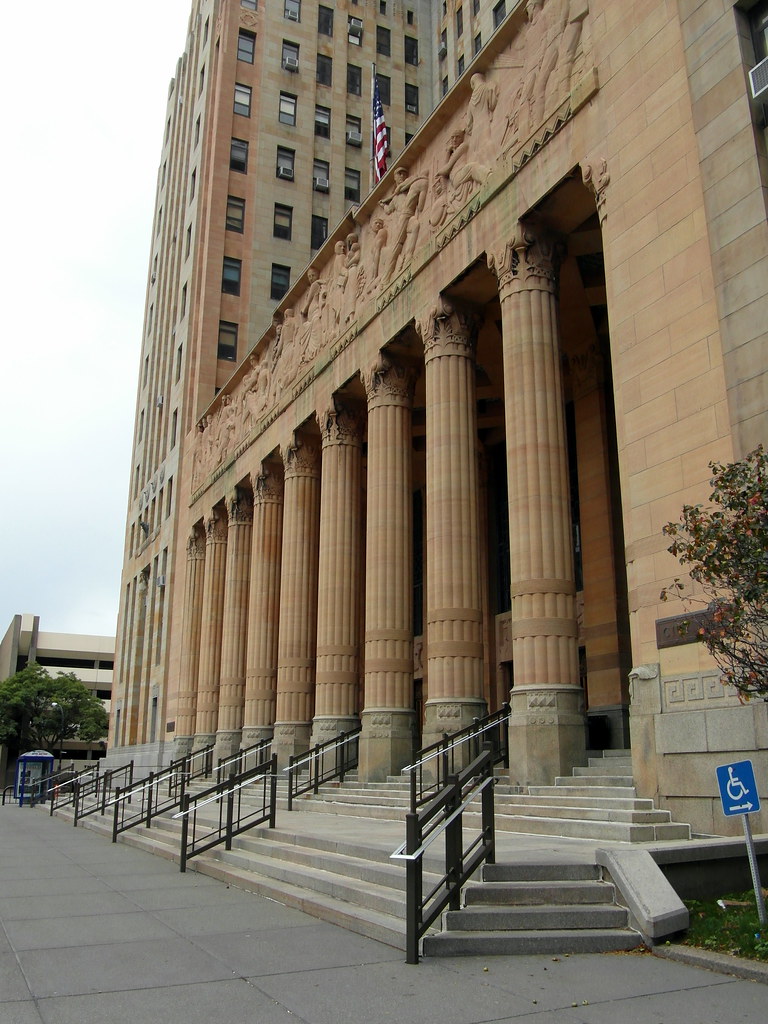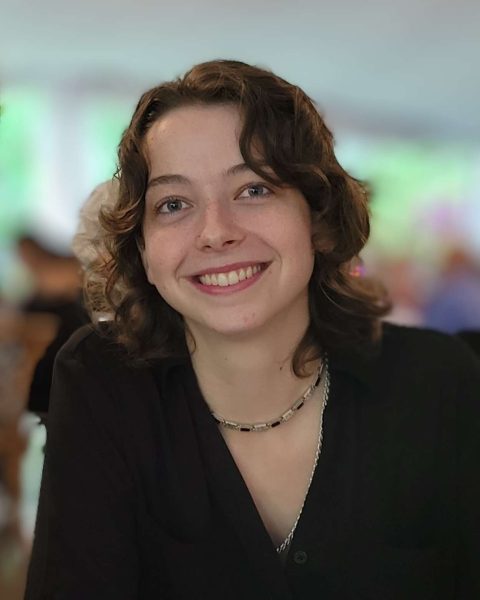Student Research and Creativity Celebration showcases student work
May 6, 2015
The lobby of the E.H. Butler Library was crowded Saturday for SUNY Buffalo State’s 17th annual Student Research and Creativity Celebration.
The event, in which undergraduate and graduate students displayed their research projects, was a combination of lectures, performances, and poster exhibits.
The posters were set up on easels in the lobby, with professors milling about and student presenters answering questions from inquiring observers. Both presenters and their faculty mentors received a 132-page program with lists of the exhibits and what times they were on display.
The event was kicked off Friday evening by Buffalo State President Katherine Conway-Turner with an opening reception.
Jill Singer, the director of the undergraduate research office and an earth sciences professor, was the event coordinator.
In an email, Singer wrote that she “recommended to campus administrators that Buffalo State initiate a campus wide research symposium” 18 years ago, thereby creating the Research Celebration.
A statement attributed to Singer, printed in the event program, identified this year’s research celebration as “the largest ever with over 375 presentations, art exhibits, and performances.”
Senior psychology major Emma O’Connor was among the students presenting posters. Her research, compiled for an honors thesis, titled “Trait Negative Urgency and Sensation Seeking Behaviors: Predictive Factors of Aggression,” was an experimental study of aggression.
Subjects in O’Connor’s study filled out a questionnaire measuring their level of negative urgency, or whether they tended to respond to frustrating situations in a negative or positive way. They were then tasked with solving a puzzle.
One of the puzzles could be easily solved, but the other was impossible to solve. O’Connor pretended to be unaware of this when she conducted the experiment and observed how aggressive the subjects became.
“What I ended up finding was that those who were higher in negative urgency in the frustration condition ended up having the most aggression,” said O’Connor. “So what I can take from that is that negative urgency is predictive of aggression, especially in frustrating situations.”
O’Connor’s research spanned two semesters and gave her a chance to do research in social psychology, her favorite division of the psychology field. She said she enjoyed presenting her findings at the event.
“It’s good,” O’Connor said. “It’s nice to see everything all together and you know, I’ve been doing this for three semesters now so it’s a nice, like, accumulation of a project, I suppose.”
O’Connor explained that the honors thesis “mimics a lot of what we do in a master’s thesis.”
“That’s sort of the point of it, to be able to get you sort of ready for that next step because I will be going on to graduate school in the fall so I already have my feet wet a little bit in what to expect as far as like, presenting a thesis goes,” she added.
Kaitlyn Gustafson, a health and wellness major and senior, was another presenter. Her poster display, “Get a Clue, Fight the Flu,” was the result of semester-long research done for her critical issues in health and wellness class.
“I actually found that only 40 percent of college students ages 18 to 24 received the flu vaccine and that it’s also a significant problem in Buffalo,” said Gustafson.
“It’s mostly due to a lack of education because there aren’t many programs that focus on college students and vaccinations and how they can not only affect themselves but the importance of receiving them as well,” she added.
She found giving the presentation to be somewhat stressful, but worthwhile.
“It was a little nerve-racking at first but it’s not too bad,” Gustafson said. “I’ve had a few people come up and ask me questions and it’s just good to talk about my topic and inform other people about what I learned.”
Besides undergraduate students, many graduate students also participated in the event. AnnMarie Henesy, a second year graduate student majoring in curriculum and instruction for administration, was presenting her master’s project at the event.
Her research study, “Non-Fiction Cross-Curricular Integration,” focused on introducing first-grade students to nonfiction books.
“It takes a variety of nonfiction in the classroom and it incorporates into a unit about science,” Henesy said. “We incorporated science and animal diversity so not only are students able to learn exactly what a nonfiction book is, what it consists of, what it contains, but they can learn from it.”
Her research will likely prove useful in the future, she added.
“I use it in my class now and hopefully I’m going to use it down the road,” Henesy said. “Because of the new Common Core and everything they want first-graders to dig right down into the nonfiction.”
Student lectures were held on the library’s second and third floors. Different departments, such as arts and humanities or psychology and social sciences, were grouped together and assigned a room for oral presentations.
Eric Gauchat was one of the speakers in the Physical Geography, Sciences, and Mathematics group.
“I like doing this rather than poster sessions personally,” Gauchat, a chemistry major and junior, said of the oral presentation. “I like the ability to talk and communicate with other members of the community or academic community, professors and students and other people that might find something interesting and getting to sit in and listen to some of the other presentations from other students.”
His presentation, “A Novel Approach to Fabricating SERS Substrate” focused on the use of Surfaced Enhanced Raman Spectroscopy, or SERS. He had previously presented his research findings in April at the SUNY Undergraduate Research Conference.
“We were hoping to make a costly, inaccessible scientific method more accessible and lower cost,” Gauchat said. “We have an instrument that is really, really valuable and the analysis it does is really important to legal work, forensic work, and research chemistry, but it has a lot of limitations so we’re trying to increase the effectiveness of the instrument by making a surface that can make its analysis.”
“Basically it’s a magnification process, but those magnifying disks are really expensive to buy so we wanted to make them in-house, inexpensively and accurately so that this technique can be applied to a wide variety of methods, including undergraduate work,” he added.
Gauchat’s research was part of an 8-week summer research project done alongside his faculty mentor, chemistry professor Dr. Jinseok Heo.
“It’s been something that my mentor has been working on for several years,” said Gauchat. “It’s an interest of his and we have several graduate students also working in the same area using raman spectroscopy in a number of different ways.”
Gauchat had not presented at Buffalo State’s research celebration until now, though.
“This is the first time that I’ve done anything here,” Gauchat said. “I’m hoping that I’ll be able to do this again next spring too.”
Email: [email protected]




